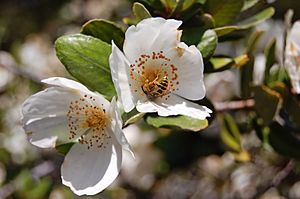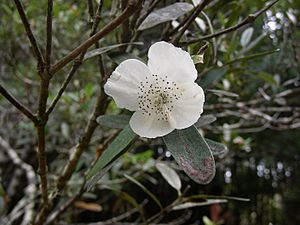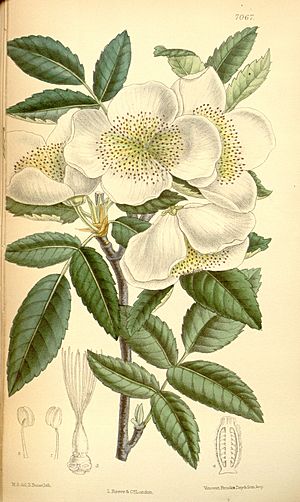Eucryphia facts for kids
Quick facts for kids Eucryphia |
|
|---|---|
 |
|
| Eucryphia cordifolia, South America | |
 |
|
| Eucryphia lucida, Tasmania, Australia | |
| Scientific classification |
|
| Kingdom: | Plantae |
| Clade: | Tracheophytes |
| Clade: | Angiosperms |
| Clade: | Eudicots |
| Clade: | Rosids |
| Order: | Oxalidales |
| Family: | Cunoniaceae |
| Genus: | Eucryphia Cav. |
| Species | |
|
See text |
|
Eucryphia is a group of beautiful trees and large shrubs. These plants naturally grow in cool, mild areas of South America and along the eastern coast of Australia. There are seven different types, called species. Two species are found in South America, and five are found in Australia. There are also several types that are a mix of two species, called hybrids.
Contents
What Eucryphia Plants Look Like
Most Eucryphia plants are evergreen, meaning they keep their leaves all year round. However, one type, E. glutinosa, usually loses its leaves in the colder months, making it deciduous.
The leaves grow in pairs opposite each other on the stem. They can be simple (one leaf) or made up of 3 to 13 smaller leaflets. The flowers appear in late summer or autumn. They are very noticeable and smell sweet. Each flower is about 3 to 6 centimeters wide and has four creamy-white petals. They also have many stamens (the parts that make pollen) and styles (parts of the female flower). The fruit is a hard, woody pod, about 1 to 1.5 centimeters long. It holds several seeds and takes about a year to ripen.
Honey from Eucryphia
The sweet liquid inside the flowers, called nectar, is a very important source of honey for two Eucryphia species.
- In Tasmania, Australia, the Eucryphia lucida tree is the main source of a special honey known as Leatherwood honey. This honey has a very unique taste. Some of it might also come from another Tasmanian species, E. milliganii.
- In Chile, South America, honey called Ulmo honey comes from the Eucryphia cordifolia tree.
Even though these two types of Eucryphia trees have been separated for over 45 million years, Leatherwood honey and Ulmo honey taste very similar!
The name Eucryphia comes from an Ancient Greek word meaning "well hidden." This might refer to how the petals hide the other parts of the flower when it's a bud.
Types of Eucryphia Species
Here are some of the different species of Eucryphia:
- Eucryphia cordifolia: This tree grows up to 40 meters tall in the Valdivian temperate rain forests of southern Chile and Argentina. Its leaves are simple, evergreen, and about 3 to 7 centimeters long. Its wood is used for building and furniture, and its nectar is used to make honey.
- Eucryphia glutinosa: This is a large shrub that can grow up to 7 meters tall. It is found in the Valdivian temperate rain forests of southern Chile. Its leaves have 3 to 5 leaflets and are usually deciduous (fall off in winter). They are 3 to 6 centimeters long.
- Eucryphia jinksii: This tree grows up to 25 meters tall in the mountain rainforests of New South Wales and Queensland, Australia. It was discovered in 1994. Its leaves are simple or have 3 leaflets, are evergreen, and are 5 to 10 centimeters long.
- Eucryphia lucida: This tree grows 20 to 30 meters tall in Tasmania, Australia. It is commonly called Tasmanian leatherwood and is a major source of special honey. Its leaves are simple, evergreen, and 3 to 7 centimeters long.
- Eucryphia milliganii: Also found in Tasmania, Australia, this plant is usually a shrub but can grow into a tree up to 6 meters tall. Its leaves are simple, evergreen, and smaller, about 1.5 to 3 centimeters long.
- Eucryphia moorei: Known as pinkwood or plumwood, this tree grows up to 30 meters tall in the temperate rainforests of New South Wales and Victoria, Australia. Its leaves have 7 to 15 leaflets, are evergreen, and are 6 to 12 centimeters long.
- Eucryphia wilkiei: This large shrub is found in the mountain top cloud forests of Queensland, Australia. It was discovered in January 1970.
Hybrids and Cultivars
A hybrid plant is created when two different species are crossed. Cultivars are special types of plants grown by people. Some of these have won the Royal Horticultural Society's Award of Garden Merit, which means they are excellent garden plants.
- E. × intermedia (a mix of E. glutinosa and E. lucida)
- E. × intermedia 'Rostrevor'
- E. × hillieri (a mix of E. moorei and E. lucida): This hybrid grew from a seed at a nursery in England around 1953.
- E. × nymansensis (a mix of E. cordifolia and E. glutinosa)
- E. × nymansensis 'Nymansay': This plant first appeared in a garden called Nymans in Sussex, England, in 1913.
- E. × nymansensis 'Nymans Silver': This is a special type of 'Nymansay' discovered in 2005. It has oval leaves with creamy-white edges.
- E. 'Penwith' (a mix of E. cordifolia and E. lucida)
- E. × hybrida (another mix of E. glutinosa and E. lucida)
Extinct Species
Scientists have found fossils of Eucryphia species that no longer exist today. These include:
- E. falcata (from the Late Paleocene period)
- E. microstoma (from the Early Eocene period)
- E. aberensis (from the Middle to Late Eocene period)
Uses of Eucryphia
Eucryphia species and their hybrids are popular small trees for gardens. When they are young, they often have a slender, cone-shaped top, which gets wider as they grow older. People like them because of their beautiful, sweet-smelling flowers that bloom in late summer and autumn. This is a time when not many other trees are flowering.
These trees grow best in places with mild winters, cool summers, and plenty of rain. Outside of their native areas, they are often grown in places like the Atlantic coastal regions of Europe, the Pacific Northwest of North America, and New Zealand.
See also
 In Spanish: Eucryphia para niños
In Spanish: Eucryphia para niños


